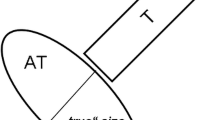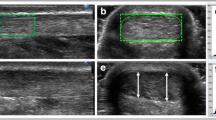Abstract
The purpose is to introduce a method for accurately and objectively evaluating volume and mean intratendinous signal within the Achilles tendon using MRI. We prospectively studied MRI from 33 patients with chronic Achilles tendinosis (20 males and 13 females) with a median age of 52 years (range 29–70). In all patients, both Achilles tendons were investigated with T1-WI as well as PD-WI MRI. Thus, 66 Achilles tendons were evaluated in the study. Tendon volume and mean intratendinous signal were evaluated using a computerized 3-D seed-growing technique. In general, the computerized 3-D seed-growing technique resulted in an excellent overall observer reliability of the MRI-measurements. The reliability (R) for tendon volume measurements was highest for the T1-WI sequence (R=97.9%). For the mean intratendinous signal, the PD-WI sequence showed the highest reliability (R=88.1%). The same pattern was present when we studied the coefficient of variation (CV). For the CV, lower figures indicate more reliable estimates. CV was 4.9% for tendon volume and 8.9% for mean intratendinous signal. In conclusion, it could be said that a computerized 3-D seed-growing technique to monitor and evaluate the volume of the Achilles tendon and mean intratendinous signal, using MRI, shows an overall excellent reliability regarding inter- as well as intra-observer reliability.




Similar content being viewed by others
References
Alfredson H (2003) Chronic midportion Achilles tendinopathy: an update on research and treatment. Clin Sports Med 22(4):727–741
Åström M, Gentz CF, Nilsson P, et al (1996) Imaging in chronic Achilles tendinopathy: a comparison of ultrasonography, magnetic resonance imaging and surgical findings in 27 histologically verified cases. Skelet Radiol 25:615–620
Fahlström M, Jonsson P, Lorentzon R, Alfredson H (2001) Chronic Achilles tendon pain treated with eccentric calf muscle training. Knee Surg Sports Traumatol Arthrosc 11(5):327–333
Fleiss JF (1986) The design and analysis of clinical experiments. Wiley, New York, p 7
Kader D, Saxena A, Movin T, Maffulli N (2002) Achilles tendinopathy: some aspects of basic science and clinical management. Br J Sports Med 36(4):239–249
Karjalainen PT, Aronen HJ, Pihlajamaki HK, Soila K, Paavonen T, Bostman OM (1997) Magnetic resonance imaging during healing of surgically repaired Achilles tendon ruptures. Am J Sports Med 25:164–171
Maffulli N, Regine R, Angelillo M, Capasso G, Filice S (1987) Ultrasound diagnosis of Achilles tendon pathology in runners. Br J Sports Med 21(4):158–162
Möller M, Movin T, Granhed H, Lind K, Faxèn E, Karlsson J (2001) Acute rupture of tendon Achillis. A prospective randomised study of comparison between surgical and non-surgical treatment. J Bone Joint Surg Br 83(6):843–848
Movin T, Kristoffersen-Wiberg M, Shalabi A, Gad A, Aspelin P, Rolf C (1998) Intratendinous alterations as imaged by ultrasound and contrast medium-enhanced magnetic resonance in chronic achillodynia. Foot Ankle Int 19:311–317
Neuhold A, Stiskal M, Kainberger F, Schwaighofer B (1992) Degenerative Achilles tendon disease: assessment by magnetic resonance and ultrasonography. Eur J Radiol 14(3):213–220
Rolf C, Movin T (1997) Etiology, histopathology, and outcome of surgery in achillodynia. Foot Ankle Int 18 (9):565–569
Shalabi A, Kristoffersen-Wiberg M, Aspelin P, Movin T (2001) MR evaluation of chronic Achilles tendinosis. A longitudinal study of 15 patients preoperatively and two years postoperatively. Acta Radiol 42:269–276
Shalabi A, Kristoffersen-Wiberg M, Aspelin P, Papadogiannakis N and Movin T (2002) Dynamic contrast-enhanced MR imaging and histopathology in chronic Achilles tendinosis. A longitudinal MR study of 15 patients. Acta Radiol 43:198–206
Streiner DL, Norman GR (1989) Health measurement scales. Oxford University Press, Oxford, 83–85
Author information
Authors and Affiliations
Corresponding author
Rights and permissions
About this article
Cite this article
Shalabi, A., Movin, T., Kristoffersen-Wiberg, M. et al. Reliability in the assessment of tendon volume and intratendinous signal of the Achilles tendon on MRI: a methodological description. Knee Surg Sports Traumatol Arthrosc 13, 492–498 (2005). https://doi.org/10.1007/s00167-004-0546-0
Received:
Accepted:
Published:
Issue Date:
DOI: https://doi.org/10.1007/s00167-004-0546-0




